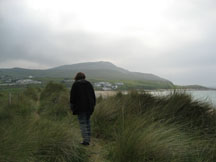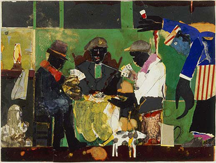Syllabus - Print Version [PDF]
Course
Description
 Everyday
life in contemporary society is characterized by a constant flow of
images. On billboards, TVs,
subways, and buses; in magazines, newspapers, emails, and airport terminals;
the fast-paced production of images has revolutionized the way we communicate with and influence one another. At the same time, a well-established tradition of looking at objects and images in museums, galleries, and
movie theaters encourages us to slow down the pace of life and to reflect on
the meaning and value of images. Occasionally we may even find ourselves gazing at photographs,
paintings, buildings, or other people for the simple pleasure of seeing. But rarely do we stand back from our
visual experience and ask how this visual culture works and how it affects the
way we think and interact with one another.
Everyday
life in contemporary society is characterized by a constant flow of
images. On billboards, TVs,
subways, and buses; in magazines, newspapers, emails, and airport terminals;
the fast-paced production of images has revolutionized the way we communicate with and influence one another. At the same time, a well-established tradition of looking at objects and images in museums, galleries, and
movie theaters encourages us to slow down the pace of life and to reflect on
the meaning and value of images. Occasionally we may even find ourselves gazing at photographs,
paintings, buildings, or other people for the simple pleasure of seeing. But rarely do we stand back from our
visual experience and ask how this visual culture works and how it affects the
way we think and interact with one another.
This
course is an introduction to the interdisciplinary field of visual studies. The
approach is both theoretical and practical. We look at the various attempts of
writers, artists, scientists, and philosophers to describe, question, and
explain the nature of the image, human imagination, and visual experience. How is our perception of the world
around us related to our thoughts and ideas about that world? Is seeing shaped by concepts and language
or is it independent of them? How
do we understand and make use of the things we see? What tools do we have for interpreting and talking about
visual objects and experience? How
can our study of the arts and art theory contribute to the development
of those tools? And how do the
various forms of visuality—our practices of looking and
seeing—limit or enhance our experience, agency, and visual pleasure?
The
basic theoretical concepts and principles in this course are drawn from
critical art history and theory, media studies, cognitive science, and
philosophy. Students develop the skills necessary to write effectively about
the visual world and to think productively about the creation of images and the
meanings that surround them.
Requirements
for Credit Students
 There
will be regular reading assignments and discussions [20%]; several
response papers, study questions, and exercises [20%]; a midterm exam [20%]; and a final essay (10-12 pages) [40%].
There
will be regular reading assignments and discussions [20%]; several
response papers, study questions, and exercises [20%]; a midterm exam [20%]; and a final essay (10-12 pages) [40%].
There
are lots of new concepts and interesting problems in a course like this
one. So I hope that you'll enjoy
the challenge. At each stage, what
you learn will help you move to a higher level of expertise. Each of you will be evaluated on the
basis of your own achievement -- you are
not competing with one another for grades. If everyone gains proficiency with the material, you'll all
end up with "A"s.
So
work together, help one another as much as you can, and don't hesitate to ask
me for help when you need it. I'm
not an avatar, so I won't be accessible on demand, 24/7. But I will be online for several hours
every day, and checking in periodically to answer questions and offer advice.
Critical Response Papers and Exercises
I'll
provide periodic questions and issues to address related to the readings and
class discussions. These assignments will be posted to the website with
specific due dates. Late responses will not be accepted.
Since
class discussions are meant to be collaborative and thoughtful, careful
preparation for discussion is essential. Responding in writing to the issues
discussed in the text is the best way to formulate an understanding and to clarify
and refine your own views.
Required Texts
- Modernism in Dispute: Art Since the Forties, Paul Wood, et. al., New Have & London: Yale,
1993.
- Learning to Look: A Handbook for the Visual Arts, 2nd Edition, Joshua Taylor, Chicago: University of Chicago Press, 1981.
- Pollock, Ed Harris (DVD)
- Course Packet
Schedule of Readings and Discussion
Topics
[See link to Reading Assignments in the left panel.]
Students with Disabilities
In
keeping with the University's policy of providing equal access for students
with disabilities, any student with a disability who needs academic
accommodations should contact the office of Student Disability Services. All conversations will be kept
confidential. Students requesting
any accommodations will also need to meet with Tom McDonald in the office of
Student Disability Services, who will conduct an interview, and if appropriate,
provide an academic accommodation notification letter. Mr. McDonald's office is 65 Fifth
Avenue, Room 409. He can be
reached by phone at 212 229 5472. More information through Student Services and on the University website.
Statement on Academic Honesty
 It
is expected that all work submitted for a grade in this course reflects the
work of the student submitting it. Students are encouraged to discuss their work with others (inside and
outside of class), and to exchange information, comments, and criticisms. But
keep in mind that if you borrow an idea from someone else, you must cite
the source, even if it is based on a
conversation or correspondence.
It
is expected that all work submitted for a grade in this course reflects the
work of the student submitting it. Students are encouraged to discuss their work with others (inside and
outside of class), and to exchange information, comments, and criticisms. But
keep in mind that if you borrow an idea from someone else, you must cite
the source, even if it is based on a
conversation or correspondence.
Plagiarism
or any other form of academic dishonesty will result in a failing grade for the assignment for the first offense. A subsequent offense will result in a failing grade for the
course. All instances of academic
dishonesty are reported to the Deans' office for review.
Any
student who does not fully understand the standards of academic honesty should
speak to me in advance of submitting coursework.
Preparation
for Class Discussions
1. Read
every selection at least twice.
a. Read
each selection once through quickly to get the main points of the text and to
better appreciate how the author approaches the subject.
b. Read
each selection a second time to examine very carefully the details and
structure of the argument.
2. Be
sympathetic, but critical. Often
you may feel put off by an author's language, point of view, critical approach,
etc. When this happens, it's
always a good idea to try to see it from the author's point of view. Then, when you understand why someone
would write in such a way or adopt such a view, you'll be in a better position
not only to understand it but to critically evaluate it.
3. Take
notes and look up unfamiliar words.
4. Read
analytically by asking the following questions:
a. What
is the central idea, thesis, objective or function of this text?
b. Which
statements, examples, or strategies in the text support this objective? Is
there anything about the text that undermines what you have identified as
"the central objective"?
c. What
are the key terms and how are they defined?
d. What
assumptions does the text make? (These may often be unstated or hidden
assumptions, so you may have to "read between the lines" to find
them.)
e. What
are some of the important implications of the position taken in the text?
5. In
cases where you disagree with the text, articulate clearly what you disagree with and what reasons support your own view.
This
analysis, together with your questions and responses to the readings, will form
the basis of our weekly class discussions.
 Everyday
life in contemporary society is characterized by a constant flow of
images. On billboards, TVs,
subways, and buses; in magazines, newspapers, emails, and airport terminals;
the fast-paced production of images has revolutionized the way we communicate with and influence one another. At the same time, a well-established tradition of looking at objects and images in museums, galleries, and
movie theaters encourages us to slow down the pace of life and to reflect on
the meaning and value of images. Occasionally we may even find ourselves gazing at photographs,
paintings, buildings, or other people for the simple pleasure of seeing. But rarely do we stand back from our
visual experience and ask how this visual culture works and how it affects the
way we think and interact with one another.
Everyday
life in contemporary society is characterized by a constant flow of
images. On billboards, TVs,
subways, and buses; in magazines, newspapers, emails, and airport terminals;
the fast-paced production of images has revolutionized the way we communicate with and influence one another. At the same time, a well-established tradition of looking at objects and images in museums, galleries, and
movie theaters encourages us to slow down the pace of life and to reflect on
the meaning and value of images. Occasionally we may even find ourselves gazing at photographs,
paintings, buildings, or other people for the simple pleasure of seeing. But rarely do we stand back from our
visual experience and ask how this visual culture works and how it affects the
way we think and interact with one another. There
will be regular reading assignments and discussions [20%]; several
response papers, study questions, and exercises [20%]; a midterm exam [20%]; and a final essay (10-12 pages) [40%].
There
will be regular reading assignments and discussions [20%]; several
response papers, study questions, and exercises [20%]; a midterm exam [20%]; and a final essay (10-12 pages) [40%]. It
is expected that all work submitted for a grade in this course reflects the
work of the student submitting it. Students are encouraged
It
is expected that all work submitted for a grade in this course reflects the
work of the student submitting it. Students are encouraged